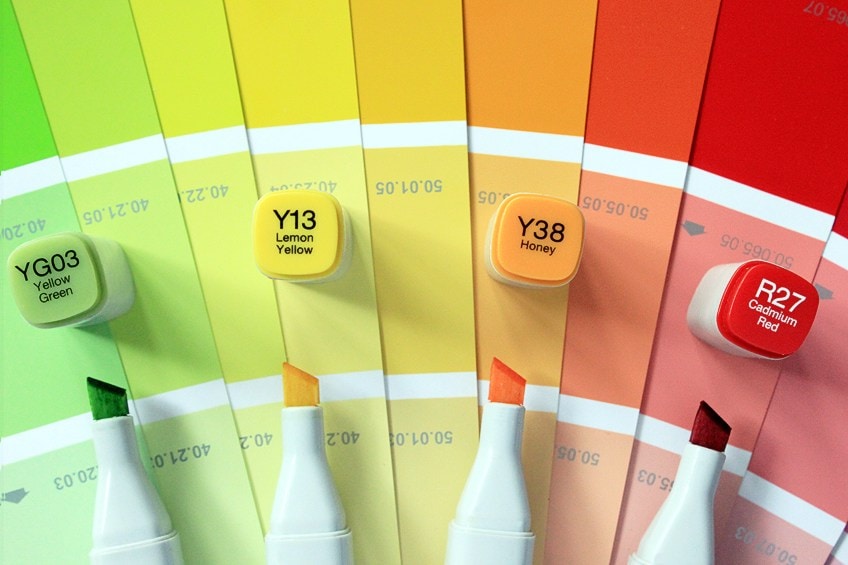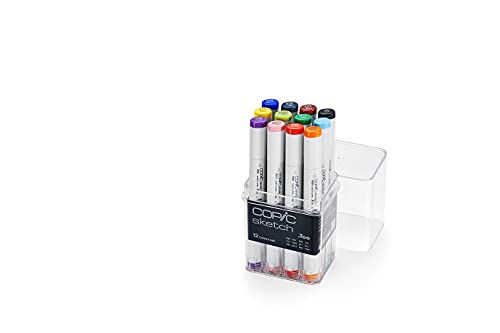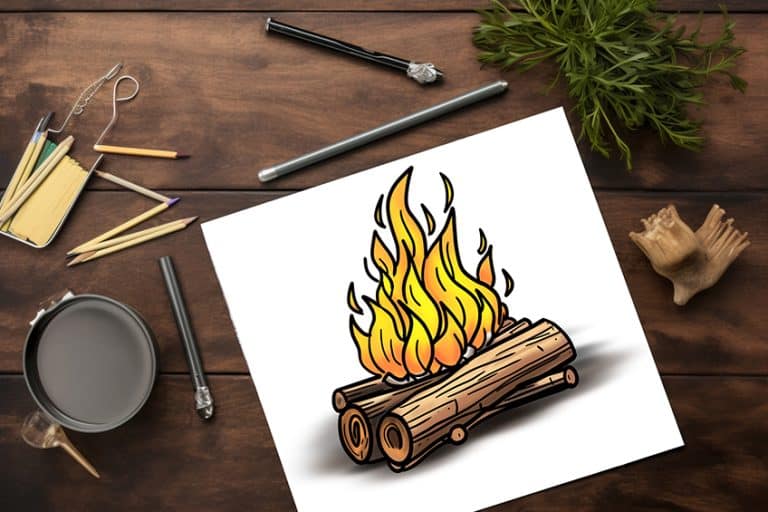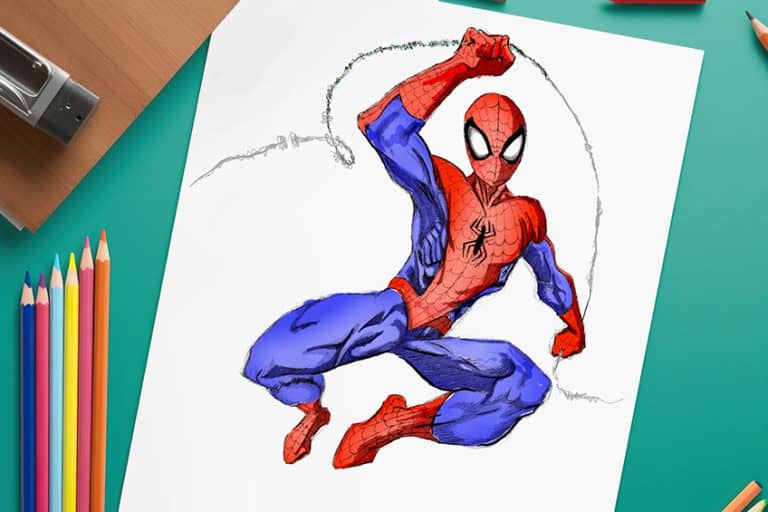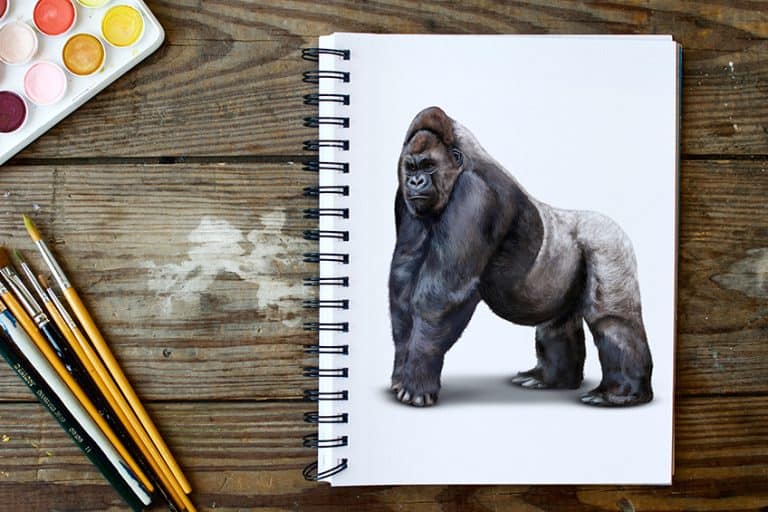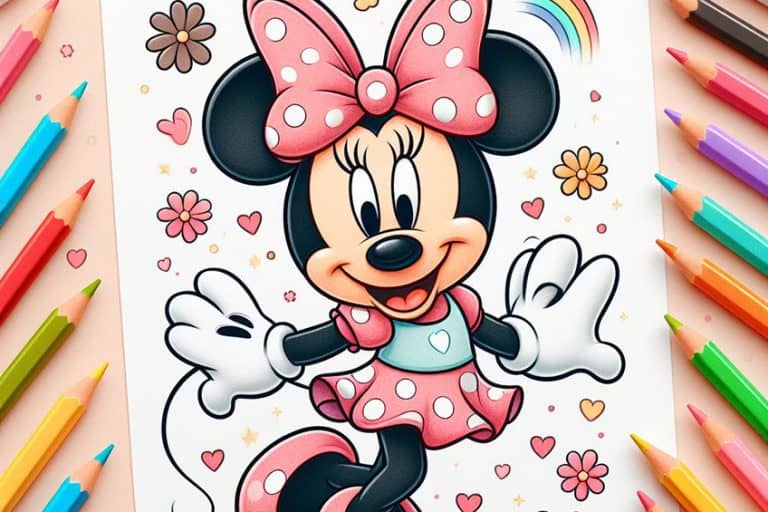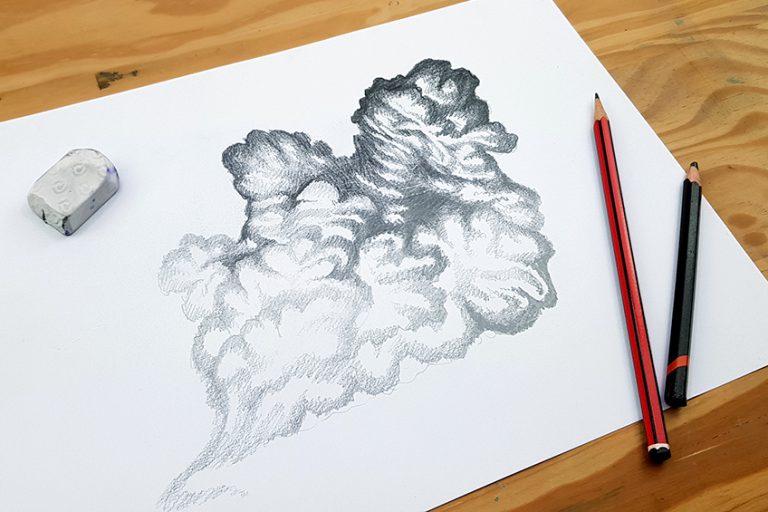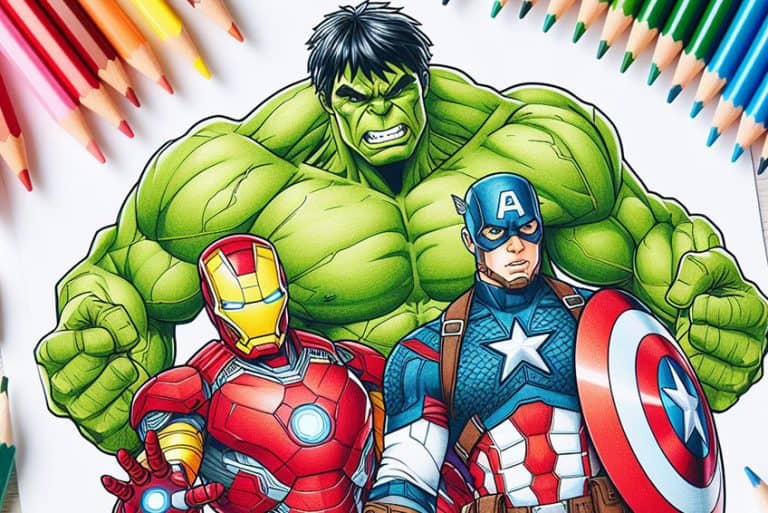Best Art Markers – A Guide to Selecting the Best Markers for Artists
Can you remember when you were younger using Crayola wax crayons, colored pencils, and markers, for coloring and drawing? This might give the impression that markers are associated with children’s art. However, as adults, we have often used them for coloring and sketching ourselves. Professional artists also make use of markers for their illustrations, sketches, and calligraphy. Drawing markers have also been found in the hands of architects and fashion designers. We will be discussing all the types of markers, the best art markers available, and a few tips and tricks along the way.
What Are Art Markers?
Art markers are alcohol-based sketching or drawing instruments that are used for creating art pieces. Many of the markers usually have double tips for ease of use and more of a choice in a single pen. Most of the products also come in art marker sets. However, why should you even consider an art marker?
Art or alcohol-based markers are recognized for their excellent coverage and diversity of colors they provide. Markers also dry instantly, leaving a brilliant, smudge-free, and durable sketch or drawing.
The regular, or water-based markers do not blend very well and leave you with a streaky look, and are unable to give your sketch or art piece that professional and smooth result. These types of markers are excellent for kids and families and are for everyday drawing and sketching. These markers are also harmless, and kids can easily use them. Unfortunately, they take a lot longer to dry and the colors are not as vibrant and clear as the artist markers.
Artist markers, on the other hand, provide you with excellent blending ability, allowing you to create that perfect art piece with a smooth and professional look. Artist markers have several special features such as replaceable nibs, double tips, and refillable ink systems, giving you the ability to produce art everyone will admire.
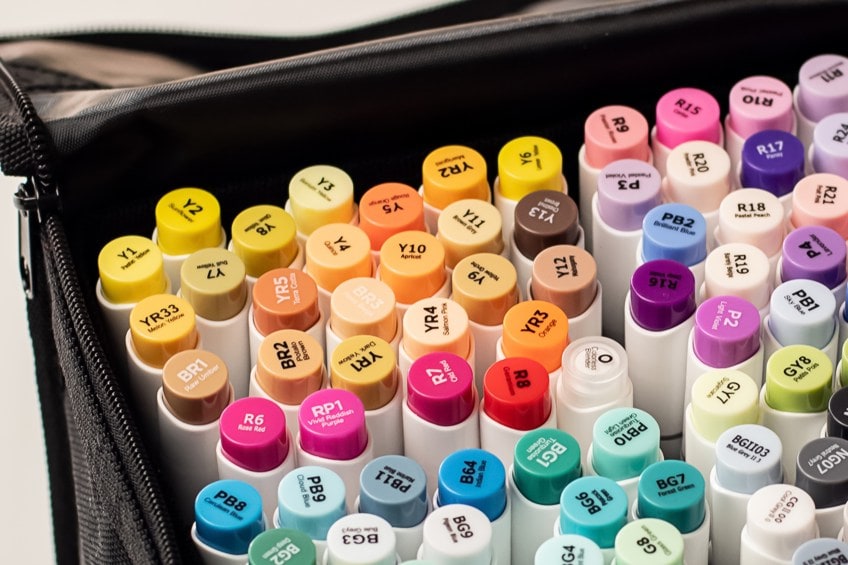
A Short History of Art Markers
Ever since 3200 BC, the ancient Egyptians were writing and drawing with ink. However, once pens were invented, this made ink application a lot easier, and it was not long after that when markers were created. The process all started in 1910 when Lee Newman had the very first felt-tip marking pen patented. Then in 1926, Benjamin Paskach invented the very first fountain paintbrush. It was only in the 1950s when Sidney Rosenthal created Magic Markers that art markers became popular. Magic Markers were being used for almost everything from posters to labeling, lettering, and all kinds of other uses.
Today, drawing markers are used by most professional artists, architects, and everybody else including children.
How Do Art Markers Work?
There are no special tools needed to get your art marker working. All you need to do is take off the cap and you can start sketching or drawing. Art markers do not have to be activated first before you can use them, unlike oil-based markers. The oil-based markers need you to press them down on the paper first before you can start drawing or sketching with them.
Most of the art marker sets come with a blending tool, which is a marker that is colorless and helps to spread your ink, giving you that high-quality blended effect.
The key difference between the types of markers lies in the type of colorant that is used. There are different types of colorants used in the markers and include ink, dye, and paint. These colorants are usually suspended in water, alcohol, or solvent-based mixture.
Art markers are used extensible by art enthusiasts, design professionals, students, architects, and of course children or anybody who enjoys coloring or sketching. This means that if you are a professional, or you enjoy art and coloring as a hobby, then you should have a set of art markers in your possession.
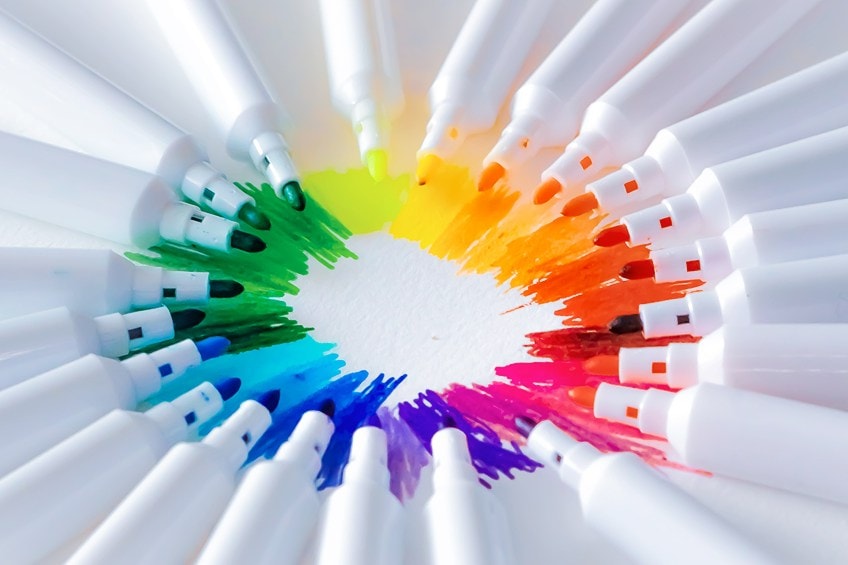
Different Types of Artist Markers
Art markers fall into three main categories namely water, alcohol, or solvent-based markers. This indicates the type of solution that is used with the dye or the ink. The best art markers have also been divided into two groups:
- High-quality markers that are used by professionals;
- The lower grade marker, which is usually a water-based marker and is used by kids, at school, or with the family.
Art markers usually have different options available. There are art markers that have nibs with a brush-like shape, very similar to that used by watercolor brushes, which are normally used by professionals who want to create a watercolor-like effect with their art pieces.
Then you can get art markers that have dual tips, one end of the pen has a bullet tip, while the other end has a fine tip. These markers can be used on any number of projects such as sketching, calligraphy, and adult coloring. There are also art markers that have a chisel tip, which is used to draw thinner, thicker, or sharp lines, and are mainly used in calligraphy.
Alcohol-Based Art Markers
Inside this marker, the ink is combined with alcohol that dries instantly and leaves a permanent mark. Due to the alcohol inside the marker, it has a very strong smell and may irritate your lungs and eyes, so it is advisable to use them in a well-ventilated area.
The alcohol-based markers are waterproof and, as they are soluble in alcohol, you will be able to blend the ink by using a blender marker, rubbing alcohol, or even another marker that has a similar color.
You must be cautious when blending, as it may leave streaks. To avoid this, you can saturate the whole surface of the paper with the color, or you can fill the whole surface of the paper with a blender before you start applying the color marker. You can easily layer your colors without causing damage to the paper, which is one of the best features of these markers. This is not the case with water-based markers, which have the opposite effect.
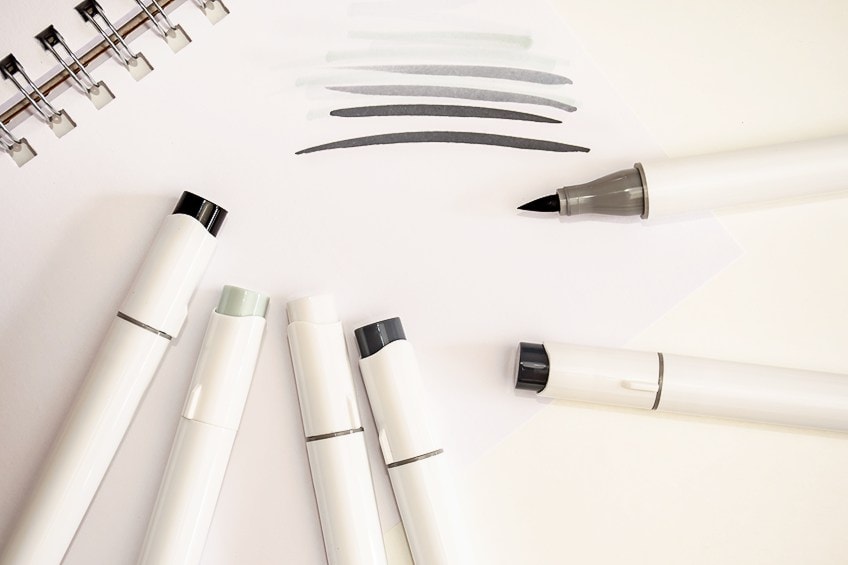
Water-Based Art Markers
Inside this marker, the ink is blended with water or there is a combination of water along with glycerin. The water-based markers are chemical-free and, therefore, odorless and are safe for children to use. These markers are also ideal for use in calligraphy and all types of art projects.
The water-based markers are waterproof, cloudy, or milky and they take longer to dry than the alcohol-based markers. When using these markers, you need to take care as it is easy to saturate and damage your paper if you use too many layers.
Apart from the water-based markers that are available on the market, there are also water-based pens that are ideal for use on heavy watercolor paper. When applying some water to your artwork piece, both the water-based marker and the water-based pen can produce amazing results. There is also the option of using your water-based markers together with your alcohol-based marker.
However, you need to use the alcohol-based marker first and then the water-based one, as the alcohol can dissolve the water-based ink if used last.
Solvent–Based Art Markers
The solvent-based, which also falls under the oil-based art marker, combines chemicals like xylene, butyl, isobutyl ketone, and methyl in the ink. These chemicals in the markers produce a very strong odor and can irritate your lungs and eyes, so you need to be careful and use them in a well-ventilated area. However, you can also now get the non-toxic and xylene-free options.
The ink in this type of marker is durable and waterproof but is not completely permanent. The solvent-based markers are used mainly on arts and crafts projects and can be effective when used on non-porous or porous surfaces alike.

Comparison Table for Artist Markers
We have just covered the different types of art markers, which include water, alcohol, and solvent-based. However, to understand the different types better, we have compiled a table listing most of the properties of each type of art marker.
| Water-Based Art Markers | Alcohol-Based Art Markers | Solvent/Oil-Based Art Markers | |
| Cost | Cheaper than most other markers | Affordable to expensive, depending on the brand | Affordable to expensive, depending on the brand |
| Colors Available | Fewer colors (About 60-96 colors, depending on the brand) | Most colors (Copic Markers: 358 separate colors available) | Depends on brand (Several to 130 colors) |
| Color Quality | Good | Excellent | Excellent |
| Refillable | ✘ | ✔ | ✘ |
| Fade-Resistance | Poor | Good | Excellent |
| Drying Time | Dries fairly quickly | Dries very quickly | Dries fast |
| Strong Odor | Odorless | Strong odor | Strong odor (non-toxic formulas available) |
| Bleeding Through | No bleeding | No bleeding | No bleeding |
| Blendability | ✔ | ✔ | ✔ |
| Replaceable Nibs | ✘ | ✔ | ✔ (some brands are not) |
| Durability | ✔ | ✔ | ✔ |
| Marker Tips | Dual-purpose tips | Dual-purpose tips | Replaceable tips |
| Ink Quality | Good | Excellent | Excellent |
Things to Consider When Purchasing Your Art Markers
When you consider buying your art markers, it can be very difficult to choose the right one as there are many options available. Many times, you will only discover the right marker once you have used them. This is why we will be helping you with your choice so that you do not have to buy thousands of markers before you arrive at the best markers for drawing. Here are a few factors you need to take into account so that you do not spend money unnecessarily on markers that do not work for you.
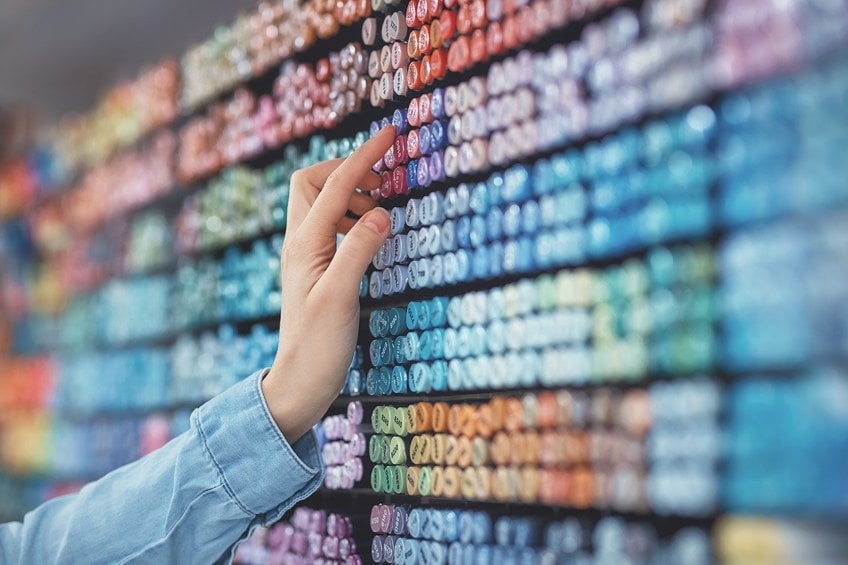
Paper
The very first thing you need to consider has nothing to do with markers, it takes into account the type of paper you are going to use. When it comes to painting or drawing with your markers, the type of paper you use is very important as bonded or thicker paper can hold the layers of ink much better than a thinner type of paper.
You need to ensure that the paper you use will not cause the marker ink to bleed through but can hold the layers of the ink. Many artists make use of sketchbooks, and this type of paper helps to hold the layers of ink quite well. So, before you start to sketch or draw, make sure you have the right type of paper.
Type of Application
Each type of art marker brand has its particular characteristics, and the best choice of marker lies in the type or kind of artwork you are going to do. You may be a professional designer, an architect, or an artist; therefore, you will have different reasons for the type of marker you use. On the other hand, you may just be a child or an adult that wants to get involved with art, or you might simply enjoy sketching or painting.
No matter what your application, you need to buy the type of marker that suits your particular situation.
Even the professional markers differ from one person to the next, as one may be a Manga or comic book artist, yet others create architectural blueprints. Let us not forget the children who love to sketch or color. Each artist or person makes use of markers in different ways, and there are markers for each need, which is why you need to define your application.
If you are looking for certain effects to add to your artwork like pastels, watercolors, or deep coloring, you need to ensure you use the correct type of markers. The perfect marker will give you the effects that you are looking for in your artwork.
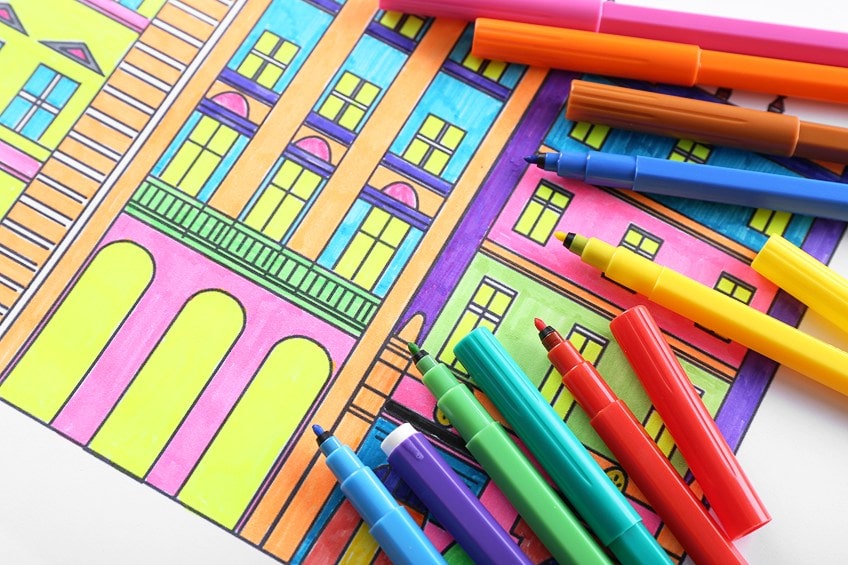
Ink Quality
The ink quality is very important, as no two markers are the same, and each has its pros and cons. The cost of each marker also depends on the ingredients. The ink in the art markers falls under three main categories:
- Water-based
- Alcohol-based
- Solvent-based
Water-based markers are popular, especially amongst the kids as they have no odor, are waterproof, and do not dissolve in most of the solvents. Alcohol markers make blending colors a lot easier, and they are waterproof. However, they can dissolve in alcohol, which you use when blending or thinning your colors. They also have an odor due to the alcohol, however, this evaporates very quickly, leaving the permanent colors.
The solvent-based markers make use of three solvents, providing durable and bright colors, but the colors are not permanent. This type of marker, unfortunately, has a strong odor when used.
The quality of the ink is vital, as a low-quality ink will not be easy to blend, and bendability is important to give you a uniform look. A low-quality ink marker does not have a smooth application and overlaps are visible once you have applied it to the paper. Try to buy a marker that disperses the correct amount of ink.
Ink Color Choices
If you are a beginner, you need to choose an art marker set that has all the primary colors, and you can always build up your collection as you go along. You need to choose an art marker brand that offers you various shades of colors you can use. If you are a professional, then go for the professional markers that group their markers as per type. For example, markers that only have flesh tones.
This will save you a lot of money as you will not have to purchase a large set just to use the flesh tone options.
By choosing the alcohol-based art markers, you will be able to mix and thin the colors to create new shades, providing a great deal more choices. They also offer a larger range of color options with bright colors that will not bleed through. Remember, markers do not have to comply with lightfastness testing standards, which means even if the marker states it is permanent, it does not mean it will last forever and may fade over time.
You can buy multiple color packs at once, but if you do this, it is advisable to stick to the same brand. This is evident in some of the brands that sell a lot of different color packs but each one can differ in subject matter or style.
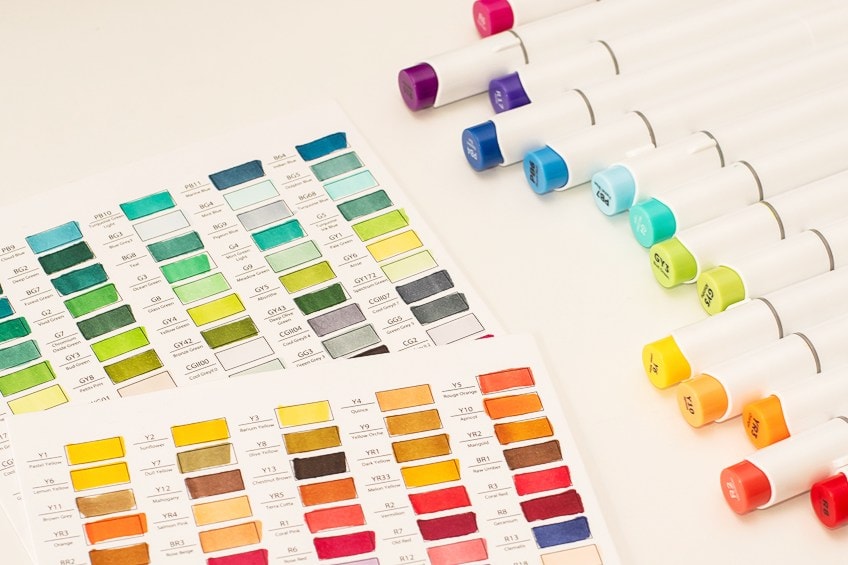
Marker Nibs and Tips
Art markers come in a range of tips including fine, brush, bullet, as well as a chisel shape. So, you need to ensure you know what type of drawing you are going to be doing, how you intend to use the marker, and what type of medium you are going to use.
Fine Tip
The fine-tipped markers are used mainly in detailed work where the space is limited, such as in manga or comic book sketching. These types of markers prove to be impractical when it comes to larger blocking of colors. This type of marker is ideal for creating detailed designs, writing, and simply doodling.
Chisel Tip
The chiseled tip markers are ideal for filling in blank areas with certain colors, allowing you a wide coverage with fewer strokes. Depending on how you hold the marker, you can draw different lines. The different edges of this type of tip can be used for different purposes, the wide edge is ideal for covering large areas, while the pointy side can be used for drawing thinner lines.
Bullet Tip
The bullet-tipped markers are the cheapest on the market and painting with them can be slow as it is not a very versatile tip. However, they are ideal for writing on fabric, drawing, and outlining designs. You can draw thicker lines with a bullet-tipped marker more easily and be precise because of the inflexible nib of this marker.
Brush Tip
The brush tip is the most versatile of all the tips, as you can use the point for thin lines or detailed work. When the tip is flattened to form a brush, it can fill in large areas of color. These tips are also suitable for shading, but they can be expensive. Some brands have the option of replacing the worn tips.
The markers we have discussed above all have single tips, but some markers come with dual tips. This means you have one type of tip on one end, and a different one on the opposite end.
Most of these types of markers have a chisel nib on one end and a fine nib on the opposite end. The dual-tip markers can save you money as you only have to buy one marker and have two different types of tips. They are also useful as you do not have to switch or change over markers in the middle of your work. The only disadvantage with the dual-tipped markers is that the ink runs out sooner. However, you can also purchase a marker with a bigger ink reservoir.
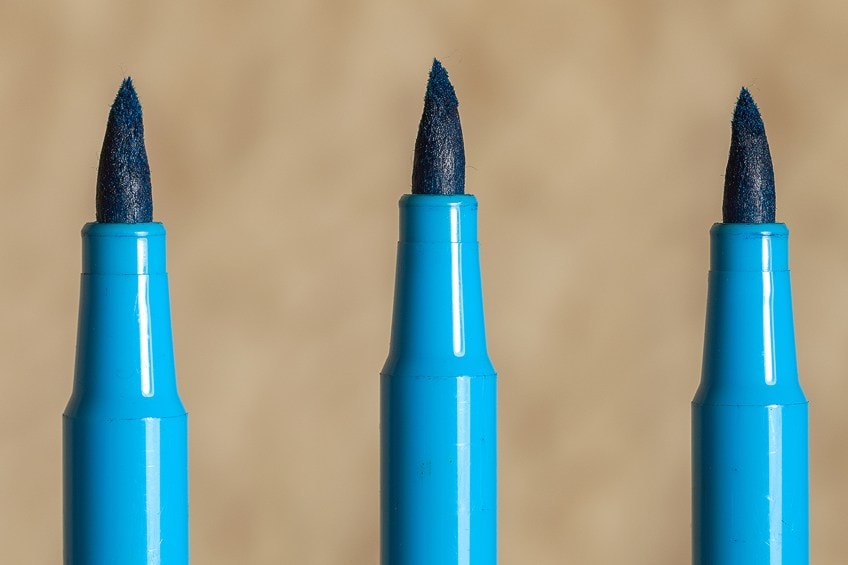
Grades of Markers
Colored pencils are divided into three grades or types; oil-based, water-soluble, and wax-based; there are also woodless pencils that consist of lead material and color sticks. The same applies to markers that also have quality grades, which fall into three categories: student, artist, and professional.
Student-Grade
The student grade markers are the cheapest of the options and are not designed for use by professional artists as they fail to give you the quality you need for your finished artwork. However, if you just want to draw or color as a hobby or get the whole family busy with some form of art, then the student grade marker is ideal.
Artist-Grade
The artist-grade marker is the one you need if you are serious about your art piece, as they are perfect for all types of applications as well as different projects. These artist markers are permanent and offer you a wide variety of bright colors but are more expensive than the student grade. You need confidence and ability or experience in working with professional markers.
Professional-Grade
Lastly, there is the professional-grade of markers that are high-quality and specially designed for professional artists. These markers give you a smooth application with a wide variety of brilliant colors. They are also double-sided and have a nib on both ends, with an ink reservoir between them. The reservoir is full of alcohol-based, high-quality ink that is non-toxic, low-odor, and streak-free.
These markers are permanent and can be blended and layered, making them the perfect choice for you to create your masterpiece.
Compared to the cheaper grade markers, which are discarded when the ink is finished, these markers can be refilled. The nibs are also replaceable once worn. Each professional-grade marker is hand-tested for color consistency and quality before it is dispatched, ensuring your marker is top quality, which makes them a lot more expensive than all other grades of markers.
Blendability
For the professional artist, it is important to choose a marker that can blend colors. This is where the alcohol and water-based markers differ a great deal. Water-based markers can leave streaks on your paper when you are blending colors, and you are never sure how the process will turn out as the water has different reactions with the dye, paper, and many other elements.
Alcohol-based markers are preferred when blending colors, as it dries much quicker than water-based markers. As the ink in these types of markers is to some extent transparent, you can layer different colors to get the effect you want. The process of blending is a lot smoother when using an alcohol-based marker than when using a water-based marker.
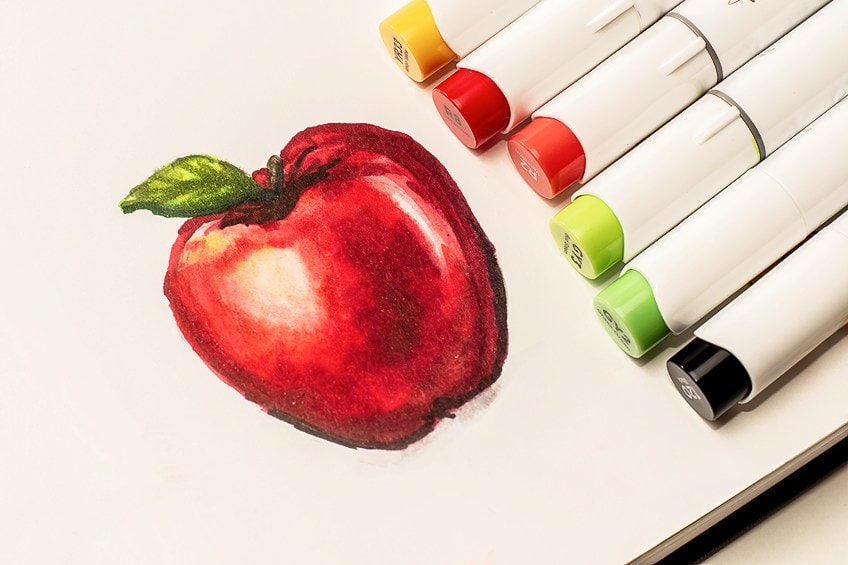
Cost
When it comes to cost, there is a huge difference as the price increases with the quality. So, if you are a hobbyist, or just sketching or drawing for fun, then the cheap art markers, which are the water-based type, is the answer. However, if you are a professional artist, then you need to consider a more expensive and better quality marker for your artwork.
Therefore, the alcohol or solvent-based markers are the ones you need when you buy your art markers. These markers offer you a wide range of brilliant colors and you also have the option of being able to refill them when the ink runs out. They also offer you more flexibility and are permanent, which means they will last for a long time.
Longevity
Irrespective if you buy cheap art markers or more expensive markers, you need to make sure that the marker does not run out of ink too quickly. This could be a major problem as it would mean that you would have to go out and buy another complete set of markers, making it more expensive and causing delays.
You need to make sure the set of markers you buy can hold a fair amount of ink, or better still, buy a set of refillable markers, leaving nothing to go to waste.
Best Art Markers
Art markers are very versatile pens to have around, as they are portable, and you can easily carry them around wherever you go. They also offer you a wide range of vibrant colors, and with the more expensive brands, you can also blend colors which gives you even more color choices.
Doing art is fun and can be enjoyed by everyone who loves sketching, drawing, and coloring. The art marker can also be used by the beginner, children, and professionals, and by buying the correct marker you can create an amazing art piece. We are now going to help you with your choice of the best marker for your project by giving you the three best art marker brand names available.
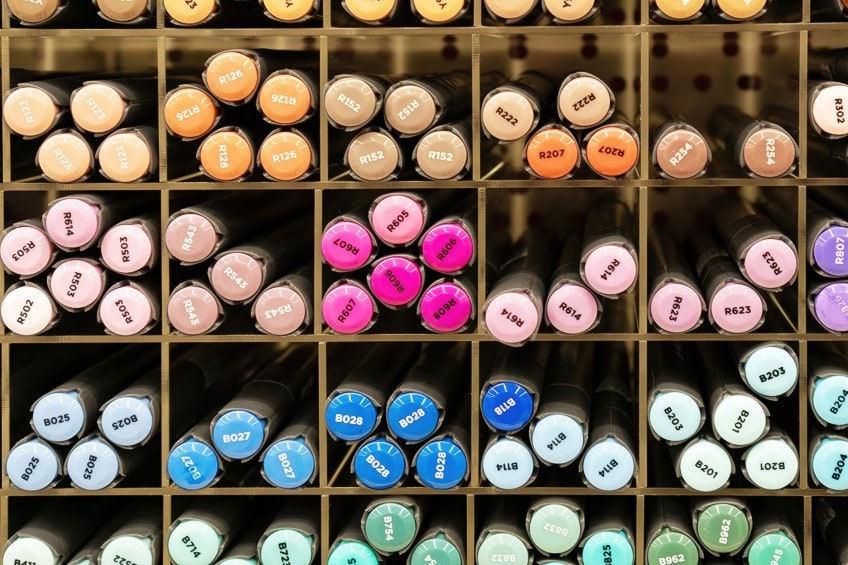
Best Water-Based Markers: TOMBOW Brush Set
The Tombow dual brush set is a water-based ink art marker set that is not an alternative to the alcohol-based art markers but is a writing tool that has a different purpose altogether. The ink is odorless, not permanent, fast-drying, and non-toxic, and the set includes a colorless blender for watercolor effects.
The pen set has often been described as watercolors in pen form and blends watercolors effectively. The markers also dry fairly quickly. You will be able to create custom colors, and with the water brush, you can also create beautiful smooth blends. Each pen contains two different tips, a flexible brush tip on one end and a fine bullet tip on the other for more versatile applications, including calligraphy.
- Ideal for fine art, brush lettering, calligraphy, illustrations, and more!
- Durable nylon brush tip can create fine, medium, or bold strokes
- Water-based ink is non-toxic, blendable, non-bleeding, and odorless
The best way to go about buying these markers is to get a set of ten colors, and you can later add them to your collection. You can also buy a whole set of pens that contain 96 colors. The sets of pens are a lot cheaper than many of the other brands, so if you are a beginner, then this option is for you. All the markers in the set come with different color-coded caps, making it easy for you to organize your pen set.
The Tombow marker set is exceptionally blendable, but due to it being a water-based ink, you will have to blend your inks on your palette first, and then, using your blender brush, you can apply it to the paper.
The ink will not bleed through the paper, but you need to ensure you use a paper that is designed to hold water-based inks. Maintenance for these markers is simple, as they clean themselves after you have done your blending.
Unfortunately, the markers are not refillable, and the tips cannot be changed. So, once the ink is finished or the tips are worn, you will have to replace the marker. The fine bullet tip can be used for intricate design and filling in details, while the nylon brush tip can do bold and medium strokes.
[su_shadow style=”simple”][su_panel]PROS
- Water-based ink so it is odor-free and non-toxic
- The nylon tips last a long time
- Contains up to 96 colors
- Extremely blendable
- Contains water brushes to be used for blending
- There is no bleeding through the paper
- Sets contain a colorless blender
CONS
- Ink is not permanent
- Not refillable
- Tips are not replaceable
- Cannot do delicate workInk needs to be blended first on a palette
Best Alcohol-Based Art Markers: COPIC Markers Set
The Copic marker set has been specially designed to boost your collection of art markers. The Copic art marker set boasts several hundred colors, but this set of 12 colors can be used for creating great sketches. This set is easy and simple to start with, and you can expand on it anytime you like. However, if you decide to go for a larger set of Copic markers, there is a 36-pack that offers you some more tone variants as well as more neutral colors.
- The markers come in a clear plastic case for easy transport
- The permanent ink is acid-free and non-toxic
- Come with refillable barrels and replaceable nibs
Each marker has a durable and robust tube that is also refillable, and the nibs are also replaceable, making it possible to change tips without having to change colors as well. These markers are alcohol-based and give you permanent ink that will not fade. The colors are also vibrant and remain smooth after being applied, it also allows you to blend your colors. The ink is fast-drying and provides you with a finish that will not smear or streak.
You may be wondering how long these markers will last due to it being an alcohol-based marker. Well, many artists have used these same markers for over 25 years, not forgetting that they are also refillable.
These art markers also allow you to re-edit your sketches without spoiling them, even after the ink has dried and there is no limit to the time. You can simply wet your sketch and make the changes you want. However, this option will only work if you use uncoated paper.
[su_shadow style=”simple”][su_panel]PROS
- Refillable ink tubes
- Replaceable tips
- Vibrant colors
- Alcohol-based with fast drying time, non-toxic, and acid-free
- Colors are arranged with numbers making it easy to identify
- High-quality permanent ink
- Excellent for layering and blending
- Can be used with the brand airbrush system
CONS
- Marker sets are expensive
- Only 12 colors in the starter set, but you also have sets with 36 colors
- Markers may leak if you do not store them correctly
Best Solvent-Based Art Markers: SHARPIE Oil-Based Paint Markers
The Sharpie Oil-based paint set of five colors will work great on almost any surface including plastic, glass, wood, metal, rubber, stone, pottery, and lots more. The oil-based paint is permanent and is released via a valve that provides excellent control on application.
The markers come with four tip sizes, which means you can apply various techniques.
This specific set has fine points, which is excellent for creating fine lines as well as bold lettering. The formula is non-toxic and can be used by children. Any application of the oil-based ink will be water-resistant and will not fade over time.
- Quick-drying, oil-based ink resists fading, smearing, and water
- High-contrast colors create opaque and glossy marks that stand out
- Fine point lays down precise, highly visible lines
PROS
- Water-resistant and non-toxic
- Ink is permanent
- Can be applied to different surfaces
- Durable
- Vibrant colors
CONS
- May have an odor, so work in an area with good air circulation
- The tip can be messy
Art Marker Brand Comparison Table
To help you further, we have drawn up a table that lists some of the best-known brands and also indicates which of the types of markers you will be able to purchase including water, alcohol, or solvent-based ink. So, if you have decided on one particular alcohol-based brand and you want to use a water-based marker, you do not have to change the brand that you are accustomed to.
| Brand name | Water-Based Art Markers | Alcohol-Based Art Markers | Solvent-Based/Oil-Based Art Markers |
| Tombow | ✔ | ✔ | ✘ |
| Pentel | ✔ | ✔ | ✔ |
| Crayola | ✔ | ✔ | ✔ |
| Copic | ✘ | ✔ | ✔ |
| Prismacolor | ✔ | ✔ | ✘ |
| Artify | ✘ | ✔ | ✘ |
| Winsor & Newton | ✔ | ✔ | ✘ |
| Chartpak AD | ✘ | ✔ | ✔ |
| Arteza | ✔ | ✔ | ✔ |
| Faber-Castell | ✔ | ✔ | ✘ |
| Sakura | ✔ | ✔ | ✔ |
How to Use Art Markers
How can you use an artist marker? This question seems a bit ridiculous, as it is only a marker, is there a right and a wrong way? Some are not familiar with how to use the markers correctly. Therefore, we are going to consider some of the best ways to use your marker, and we will be making some recommendations so that you can get the best results from your art markers.
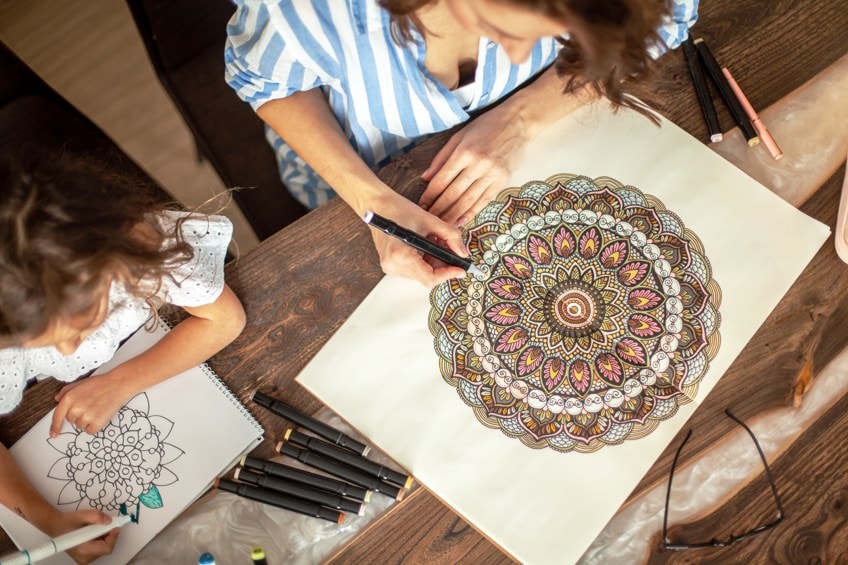
Drawing With Art Markers
The secret of using your art markers correctly lies in choosing the correct one for your project. You should have a look at all the features, how they work, and if they are comfortable to hold. You also need to consider their consistency, especially if they are water or alcohol-based, as the alcohol-based markers are more durable, but they can bleed through the paper. On the other hand, the water-based markers are odorless and washable.
Taking note of this particular feature will help you choose the right type of paper, as you will need heavy-weight paper for alcohol-based and light-weight paper for water-based markers.
When using drawing markers, it is advisable to first start with your light tones and outline the main shapes. Then you can carry on with the darker tones, but make sure you confine your drawing to a small area. If you find that you need to add some extra colors, then move on to the next small area and so go on until the whole picture is complete.
Most artists will now shade the complete picture, which can be done with a blending or shading tool, or you can make strokes of different widths. If you are going to use a tool first, ensure that it is compatible with the markers you are using, or if you are making strokes, try not to overdo the same type of stroke all the time. To get the best results, the only way is to practice and experiment until you perfect the technique.
Coloring With Art Markers
The trick to coloring is to first plan what shades you are going to use, then divide the whole area into smaller segments. Consider what shades you are going to use in what segment. Once you have done this, you are ready to start coloring. Once again, you should first start by using lighter tones and then move to the darker tones, layering the same tone or using another shade. Remember to do this in each small area or segment.
It is important to pause at certain intervals and see if you are getting the effect you desire. If not, then stop and see what needs to be fixed.
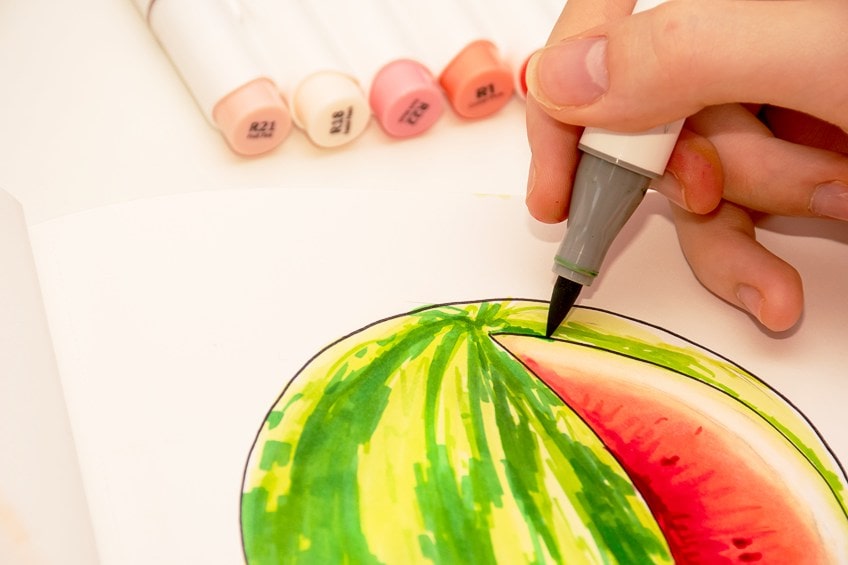
Watercoloring With Art Markers
When working with art markers, you will be amazed at what effects you can achieve on paper. However, these effects constantly depend on the marker you are working with. Some water-based marker types can produce a watercolor effect. When going for a watercolor effect, you must first apply them, and then by using a blender or wet brush, you cover the colors you applied.
You will now notice that the edges will dissolve and disperse over the whole surface. You can also experiment with this and apply the water first, then paint over the water with your water-based markers. However, the best method is to place some color next to the water and mix the two using a paintbrush or blender.
Blending With Art Markers
The technique used for blending is very similar to that of the watercolor effect, but the effect may vary depending on the number of markers you use. If you blend using only one marker, the whole area can be blended by altering the pressure you exert on the pen’s tip. You can also prepare a solution of water if you use a water-based marker, or rubbing alcohol if you use an alcohol-based marker.
This is achieved by dipping the tip of the marker in the solution and blending the area by adjusting the pressure you use. If you are working with two markers that are similar in color but varying tones, you must apply the lighter tone first and then apply the darker tone over it.
This method can also be achieved if you use two different colors.
Sketching With Art Markers
The main problem of sketching using art markers is that you may end up with a mess or you make a mistake. A great number of artists shy away from sketching with art markers as they fear they might not be able to fix or erase a mistake. When it comes to sketching with markers, you need to have an attitude that if you mess it up, you need to move on, start over, or try to creatively cover it up.
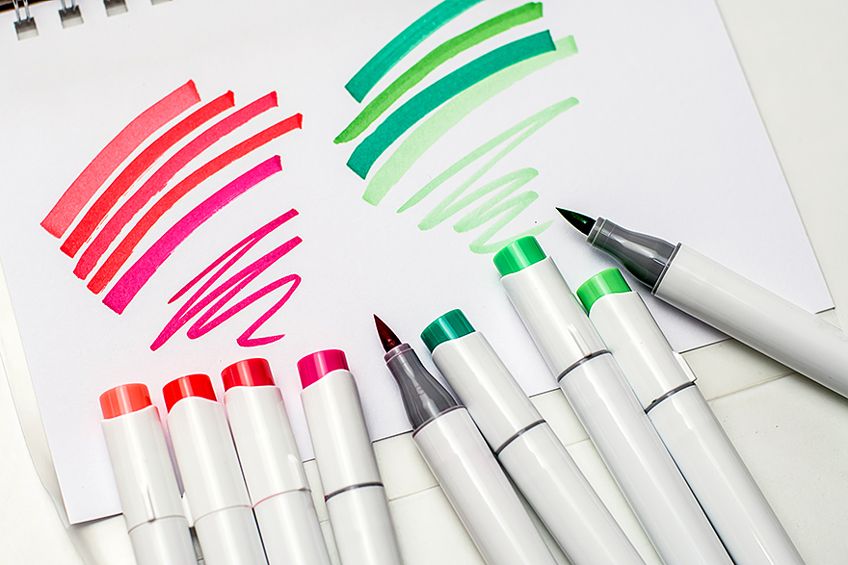
Shading With Art Markers
When it comes to shading and using art markers, you can simply apply the same technique as you do when using pencils or colored pencils. You change the tone to make darker lines, and when using one marker, you can cross-hatch lines to create a mesh-like pattern that will help to create texture and shadows. Try to avoid too much ink in one particular place, as this may ruin your drawing.
Some good advice is to first try shading with pencils, and then after you have mastered this, try it using markers.
Rendering With Art Markers
Art marker rendering means an artistic approach that focuses on illusions and impressions. This enables you to visualize a three-dimensional image on two-dimensional paper. The first thing to do is to form borders of the object you intend to render, and then you can apply your previously selected colors. For details that lack bright colors, make use of a lighter shade of gray, which will make the detail bulkier.
If your picture needs blending or you find some gradients, then you can cover over the lighter tones with a darker tone, after which, you can apply the shading method referred to above that merges two colors.
Coloring Without Streaks
This can be tricky as you cannot always make consistent lines or hold your hand in the correct position all the time. Therefore, it is recommended you try not to press too hard on the tip, causing it to fray which will produce streaks. Do not be too concerned with this issue as the problem goes away with practice.
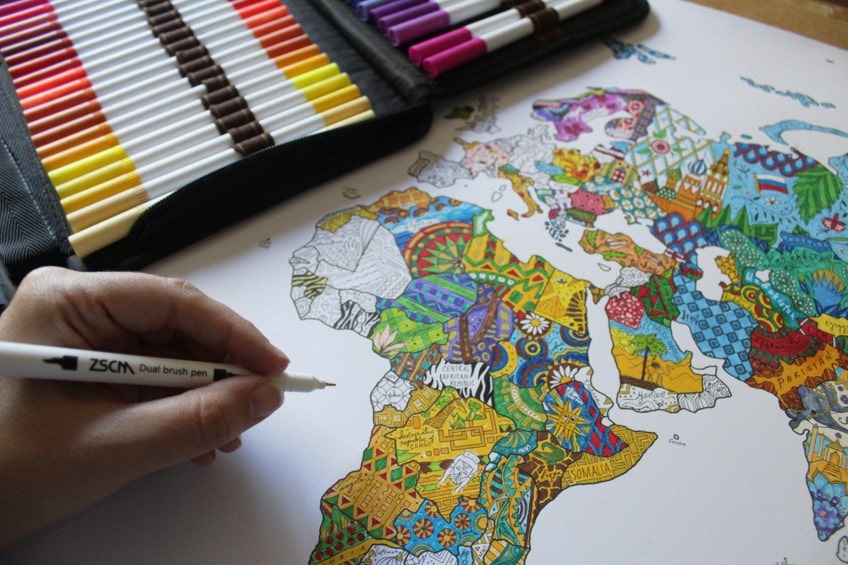
Tips and Tricks When Using Art Markers
Whether you are a beginner and just starting to experience what you can do with art markers, or if you are a seasoned professional artist, we all need to follow certain principles to produce the artwork we are looking for. So, here are a few tips to follow and we hope that as you implement them, you will be able to see the results.
- It is a big help if you can understand how each of the different types of tips performs when held at different angles, which will only come from much practice. Obtaining the various types of tips is also advantageous
- Try applying the different strokes, carefully and slowly taking note of your stroke quality, and then go faster. Always check to see the quality of your strokes
- Remember to always begin drawing using light tones of ink as they are a lot easier to cover over and fix
- You can always try using colored pencils to give you more precision and add depth of detail
- When you change your paper, do not start drawing immediately, but first, take some of your colors and use them on the old paper, and compare with the new paper.
- Do not start drawing straight away after you have done a color swatch. Rather wait a few minutes first, as the colors tend to get paler once they are dry
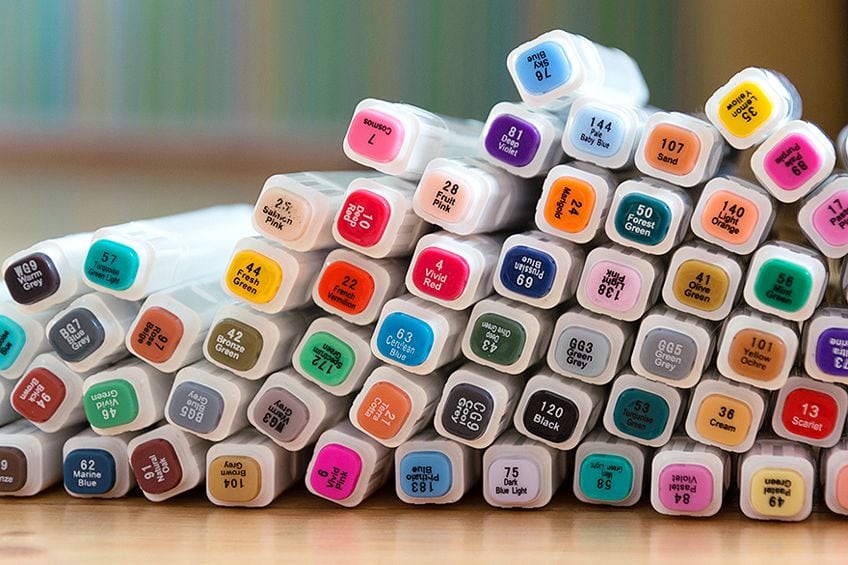
Frequently Asked Questions
What Is the Best Art Marker Brand?
There are many trusted brands, but for the professional markers, Prismacolor and Copic seem to be the most used and favored. The Copic brand is especially well-liked, as the ink is refillable and the nibs are replaceable, making it the best choice for a long-term option.
What Are the Best Markers For Drawing?
For drawing purposes, the best drawing markers need to be supplied with brush or bullet tips, as you can blend easily with them. Also, you can draw crisp lines without becoming streaky or spreading.
How Do You Apply Art Markers Correctly?
Art markers can be used the same as a pen, but select the right tip for the right job. Art markers come with two different types of tips, so use the fine tip for detailed or thin lines and the chisel tip for filling in purposes. All art marker sets come with a colorless blender, which you can use to blend your ink to give you that smooth and uniform effect. Remember to start your drawing using thick paper first.
How to Organize My Art Marker Sets?
It is a good idea to organize your markers by their color family in their carry case, ensuring the caps are visible so you can see all the colors you are looking for.
Can You Apply Art Markers on Glass?
Some of the markers can be used on glass, but you need to read the manufacturer’s label which will give you all the surfaces the marker can be effectively used on. If you want your designs to last on the glass surface, you need to use fade-resistant markers.
How Long Do Art Markers Last?
Most of the art markers are very durable and can last a few years, especially those that are refillable, and the nibs can be replaced.
What Markers Should Beginners Choose?
When starting, try to find the brand that fits your artistic style. To do this, select three of the top brands where you can mix and match until you find the right one for you. Once you have selected a brand, then you can buy a small set first, and later you can build your set further.
What Are the Best Markers for Artists?
When looking for professional markers, the Copic brand seems to be very popular. However, the Prismacolor brand is still the top brand that artists prefer, as they are alcohol-based, dual-tipped, and have the best quality inks.
Matthew Matthysen is an educated multidisciplinary artist and illustrator. He successfully completed his art degree at the University of Witwatersrand in South Africa, majoring in art history and contemporary drawing. The focus of his thesis was to explore the philosophical implications of the macro and micro-universe on the human experience. Matthew uses diverse media, such as written and hands-on components, to explore various approaches that are on the border between philosophy and science.
Matthew organized various exhibitions before and during his years as a student and is still passionate about doing so today. He currently works as a freelance artist and writer in various fields. He also has a permanent position at a renowned online gallery (ArtGazette) where he produces various works on commission. As a freelance artist, he creates several series and successfully sells them to galleries and collectors. He loves to use his work and skills in various fields of interest.
Matthew has been creating drawing and painting tutorials since the relaunch in 2020. Through his involvement with artincontext.org, he has been able to deepen his knowledge of various painting mediums. For example, watercolor techniques, calligraphy and lately digital drawing, which is becoming more and more popular.
Learn more about Matthew Matthysen and the Art in Context Team.


